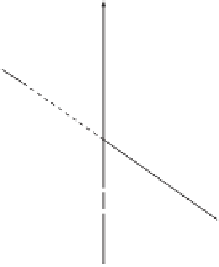Graphics Programs Reference
In-Depth Information
y
y
P
Infinite
circle
x
z
P
*
O
θ
/2
θ
z
x
k
V
(a)
(b)
Figure 4.2: Hemispherical Fisheye Projection.
therefore a variable; it depends on
P
, which is why this type of projection justifies the
name
nonlinear
.
The derivation of
s
starts with Figure 4.2b, which shows that tan
θ
=
|
P
|
/k
,im-
P
∗
|
plying
θ
=arctan[
|
P
|
/k
]. Similarly, the transformed point satisfies tan(
θ/
2) =
|
/k
,
which yields the scaling factor
=
k
tan
(arctan[
/k
])
/
2
P
∗
|
|
|
P
|
s
=
|
=
k
tan(
θ/
2)
|
.
(4.2)
P
|
P
|
|
P
|
Exercise 4.1:
Use mathematical software to compute the scale factors for several
|
P
|
values from 1 to 10,000.
If the programming language or mathematical software being used cannot compute
the arctan to the desired accuracy, the following expressions (where
h
stands for
)are
equivalent and employ only sines and cosines. From
h/k
=tan
θ
and
sh/k
=tan(
θ/
2),
we obtain
|
P
|
sin
θ
cos
θ
k
h
tan(
θ/
2) =
tan(
θ/
2)
=
1
−
cos
θ
sin
θ
=
cos
θ
(1
cos
θ
)
sin
2
θ
−
s
=
,
tan
θ
or equivalently
sh
=
k
tan(
θ/
2) =
k
1
−
cos
θ
sin
θ
.
Notice that points that are the farthest from the origin on the
xy
planehavean
angle
θ
in Figure 4.2b close to 90
◦
. Thus, their projections have an angle close to 45
◦
.
A view angle of 45
◦
implies that the distance of such a projected point from the origin
equals the distance
k
of the standard position from the origin. The result is that all
the points on the (infinitely large)
xy
plane are moved by the hemispherical fisheye
projection onto the radius-
k
circle located in the
xy
plane and centered on the origin.















Search WWH ::

Custom Search